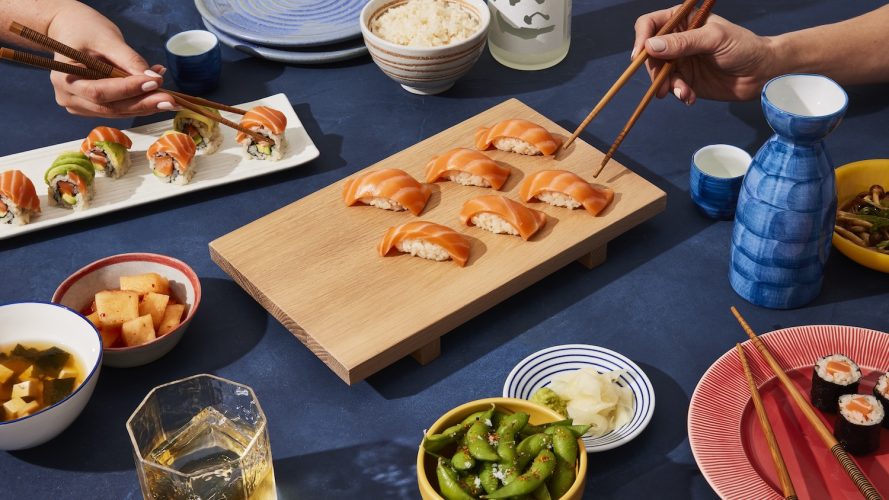Lab-Grown Seafood Might Be Coming to a Menu Near You

Wild-caught, farmed or lab-grown? These may soon be the options on your seafood menu. In June, the seafood company Wildtype launched a new sushi-grade salmon. Yet those delectable pink ribbons didn’t originate from the sea or a pond, they were grown from salmon cells in a former brewery.
In a process described as similar to brewing, the company forms cells taken from salmon into meat with no ocean or farming required. Instead, the salmon cells are grown in tanks full of a nutrient-dense liquid. Once grown, they’re combined with a handful of other ingredients to form lab-grown, or cultivated, seafood. The resulting product isn’t plant-based or vegetarian, but it may still alleviate animal welfare and environmental concerns associated with wild-caught and farmed seafood.
While a handful of companies are already producing lab-grown seafood in the United States, Singapore and Germany, Wildtype is the first company to get FDA approval to sell lab-grown fish in the U.S. Thanks to an overwhelmingly positive reception, the San Francisco-based operation has already expanded to several states. With hefty sustainability and welfare benefits, Wildtype is changing the tide — from fisheries to firecracker rolls.
Founded in 2016, Wildtype has its origins not in fisheries or aquaculture, but in biomedical research. The company was the brainchild of two friends with backgrounds in medicine, molecular biology, economics and business.
“I think that there was a moment where both of us were like, ‘Why is all of this just used for the biomedical sciences?’” said Aryé Elfenbein, Wildtype co-founder. “There are applications that are much more impactful in many ways — in terms of the numbers of people influenced by climate change and everything related to our current food production methods — and that is where a lot of this began.”
Setting up in a renovated microbrewery in San Francisco, their first task was setting up a system in which cells could grow and reproduce over time without needing to add more — a process called a self-renewing cell line. To start the line, cells were extracted from a juvenile Pacific salmon. Since 2018, this cell line has continued to grow without harvesting any additional cells from live salmon. It’s cultivated in a substance full of specific nutrients and ingredients to support growth in large steel tanks.
“It’s very much like a sports drink, meaning it’s the same kinds of things that these cells would be seeing inside of a fish,” Elfenbein said. “There are amino acids that they can turn into proteins, there are fats, sugars and then trace minerals like iron, zinc — things that all cells need. And that’s essentially it.”
These cells are then combined with several plant-based ingredients, like oils, soy, potato starch and seaweed extract. This creates the scaffolding for the meat, along with the flavor and appearance of salmon. The final product works well in dishes like sushi, ceviche or crudo, and reportedly tastes just like salmon.
While a laborious process, cultivating versus catching seafood can ultimately be beneficial for the environment. Lab-grown seafood bypasses both fishing and aquaculture, eliminating the habitat degradation, pollution and disease caused by these industries.
By decreasing the demand for fish farming and fisheries, lab-grown operations could mitigate the associated environmental impacts. For example, since the 1970s, marine stocks have been increasingly overfished, reaching over 35 percent today. Besides jeopardizing livelihoods and our food supply, overfishing can damage habitats, emit greenhouse gases and limit the ocean’s carbon-capturing ability. Farmed seafood offers an alternative to wild-caught fish, but has a host of problems of its own.
While Wildtype hasn’t conducted a formal environmental impact study on its operations yet, preliminary estimates indicate its lab-grown salmon could use up to three times less energy than conventional or wild-caught salmon. Further, its greenhouse gas emissions could be over seven times lower.
For other types of lab-grown meat, research yields mixed results. For example, studies have found that greenhouse gas emissions could potentially be both higher or lower than conventional meat, depending on the substance its grown in and the energy used.
Environmental footprint aside, by preventing slaughter, lab-grown meat brings animal welfare benefits. And because it’s grown in a very controlled environment, unlike the ocean, it has another perk: a lower risk of contamination from pesticides, heavy metals and pathogens.
And Wildtype’s product still boasts a similar nutrition profile and similar levels of the same omega-3s as wild fish.
“Today it’s pretty equivalent on most aspects except protein,” said Justin Kolbeck, co-founder and CEO of Wildtype. “We’re a little bit light on protein, and part of that is a function of the ingredients that we use … But we’re always improving it, and we hope that we’ll be at protein parity very soon.”
Despite its unusual origins, consumers have been receptive to Wildtype’s product. But the company still has a few clouds on the horizon. A handful of U.S. states, along with Italy, have banned lab-grown meat or issued moratoriums on its sale.
But Kolbeck says that Wildtype is filling a market demand with a local product.
“This country imports 80 percent of its seafood.” Kolbeck said. “So we’re also not really competing with American fishermen. If anything, we’re offsetting exports, which I think everybody in this country wants more of. We want more domestically produced food.”
Still, Wildtype is moving full steam ahead. It’s already sold at restaurants in four states — Arizona, Oregon, California and Washington — and hopes to sell its fish in grocery stores soon, too. While the company’s products sell at a premium price currently, it’s hoping that could change soon.
“We’re making a very small amount of fish because we’re in a microbrewery scale,” Kolbeck said. “So obviously, our costs will continue to go down as soon as we start producing it in much larger volumes, and we can serve additional customers, maybe in a less fancy restaurant setting. That’s the goal of where we’re going next.”
Currently, lab-grown fish may be just a drop in the ocean, but billions of people rely on seafood for protein and other nutrients. And demand is predicted to nearly double by 2050. This factor, coupled with a limited supply, has impacted the price of fish.
“The price of salmon has risen five times faster than inflation in the last 10 years,” Kolbeck said. “To me, that sounds like a good environment to introduce a new offering.”



Post Comment